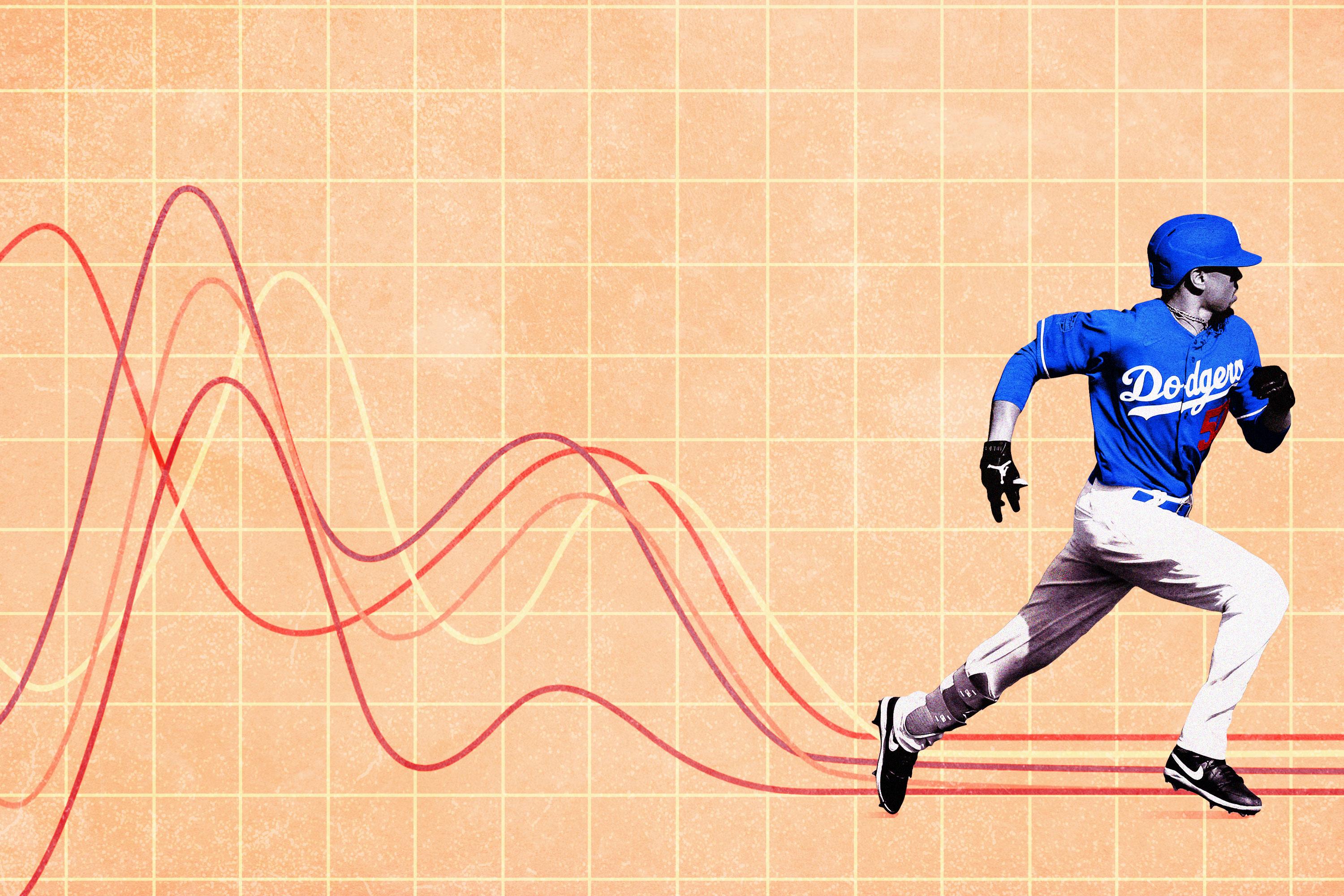
The logic behind Mookie Betts’s contract extension is blazingly obvious for its principals. Betts came out of arbitration due to make $27 million this year, and with a 12-year, $365 million extension, the full sticker price of his Dodgers contract comes to some $392 million over 13 years. That stands to make Betts, the 2018 AL MVP, hideously wealthy. “Keep a yacht in Saint-Tropez” wealthy. “Send your great-grandkids to Harvard” wealthy. “Join a consortium to buy a team after you retire” wealthy. The Dodgers, for their part, get to employ Betts from now until so far in the future they’ll be playing teams from far-flung places like Mars, or Nashville. And doing so will cost only a hair over $30 million a year, a bargain for the second-best player in baseball. Everyone goes home happy.
But appropriately enough in a sport that often seems like a microeconomics case study occasionally interrupted by pitching changes, this contract will have ripple effects far beyond its signatories. Betts has long known this. For more than a decade, it’s become standard practice for up-and-coming stars to sign under-market contract extensions with the team that drafted them. Betts is one of a group of elite players—with Gerrit Cole and J.T. Realmuto—who wanted to test the free agent waters in order to reset the market and raise top-end salaries across the game, a desire he made clear before the Red Sox traded him in February.
That turned out not to be a tenable course of action for Betts anymore. The COVID-19 pandemic has already wiped out a season’s worth of gate receipts and nearly two-thirds of a season’s worth of TV revenue, and MLB’s sponsors and media partners are similarly feeling the squeeze. The economics of the sport are not what they were six months ago. The extent of that damage is unclear so far, and will likely remain so—MLB and its franchise owners have frequently obfuscated regarding their finances, and they have every incentive to play up their own concerns of economic precarity so they can drive down free agent salaries.
It’s hard to draw too many conclusions from Betts’s extension because he is a unique player in a unique case. Not only did the Dodgers have incentive to hang on to him after trading a promising young regular (Alex Verdugo) and a top-100 prospect (Jeter Downs) to get the diminutive Tennessean, but if the Dodgers had lost Betts to free agency, there is no similar player they could have plucked off the market for money alone. Less talented and less accomplished players do not have that advantage when negotiating their own contracts. But it’s the first major economic data point since the league’s transaction freeze lifted four weeks ago, and will likely be the most significant contract signed for years to come. So while the tea leaves are imperfect, they must be consulted nonetheless.
The most notable thing about Betts’s contract right off the bat is this: The total value starts with a 3 and not a 4, even though the deal is 12 years long. Last spring, Mike Trout signed a 12-year extension worth $426.5 million. Trout is a better player than Betts (perhaps the only better player than Betts), and was the same age Betts is now, but he was also two years from free agency to Betts’s one.
The deal looks even worse for Betts when compared to other recent free agents. (“Worse” being a relative term with almost $400 million in guaranteed money coming in, of course.) Gerrit Cole, who’s two years older and a pitcher, signed for nine years and $324 million this offseason—about $5.6 million a year more than Betts. In early 2019, Bryce Harper signed a 13-year, $330 million deal while coming off a down year in the most inhospitable free-agent climate in 30 years. Anthony Rendon, who’s a great player but nowhere near Betts’s level, is making $4.6 million more per year than Betts, though it’s worth mentioning that Rendon, who’s two and a half years older than Betts, signed a much shorter contract (seven years) worth $147 million less overall.
Taking out Betts’s $27 million salary this year, the extra 12 years will pay the Dodgers outfielder about $30.4 million a year, which is just the 12th-highest average annual salary in MLB history, according to Cot’s Contracts. But while the season of lost revenue has clearly cost Betts a lot of money, things could have been much, much worse. Betts comes up short of Nolan Arenado’s eight-year, $260 million extension on AAV, but dwarfs it in total value. It also remains well clear of Christian Yelich’s nine-year, $215 million extension from earlier this spring, and it ought to: Betts is a year younger and was two years closer to free agency, and the gap between him and Yelich as a player is bigger than the gap from him to Trout.
This contract means that the market for top-end free agents has taken a hit but has not completely cratered, which has to come as a relief to this coming offseason’s top free agents: George Springer, Masahiro Tanaka, the Marcuses Semien and Stroman, and Realmuto, whose own extension talks have stalled despite Harper’s shouted exhortations. Given the owners’ rhetoric during negotiations over the game’s resumption, there was reason to fear that Betts would reach free agency and find himself facing no better offers than the seven-year, $175 million deal Manny Machado reportedly turned down from the White Sox two years ago.
But it’s now abundantly clear that Trout’s extension has capped the market for the foreseeable future. While MLB has neither a salary cap nor a maximum individual salary, in the 21st century a long-term deal by the best player in baseball serves as an informal maximum salary. In December 2000, Alex Rodriguez agreed to terms on a record-breaking 10-year, $252 million contract with the Texas Rangers, making him the highest-paid player in baseball in terms of AAV and overall value. In 2007, he renegotiated his deal to pay him $275 million over 10 more years.
It wasn’t until 2014 that Clayton Kershaw made more than that per year on a multiyear deal, becoming the first $30 million–a-year player. A year later, Giancarlo Stanton beat A-Rod’s contract on total value, but on a 13-year deal that paid him less per season than A-Rod made in 2001. Trout’s extension, signed last year, truly reset the market, but after taking inflation into account he’s making $1 million a year less now than A-Rod was making in 2001.
And inflation hardly provides sufficient context to a 20-year run in which annual MLB revenues nearly tripled and franchise values increased in some cases by a factor of 10. Trout became the country’s first athlete to sign a $400 million deal, but he would’ve been a bargain at twice the price.
With a full season of record revenue, and the gigantic paydays Cole, Rendon, and Stephen Strasburg picked up last winter, there was reason to believe that Betts could incite a bidding war and push superstar salaries into the $40 million–a-year range for the very first time. But having only the Dodgers to negotiate with, and a scary and uncertain road to free agency, Betts could take in only about 85 percent of what Trout made.
That makes a certain degree of intuitive sense—Betts is almost as good as Trout, so he should get paid almost as much. But in terms of age, track record, and performance, there’s nobody coming down the free agent pipeline in the next three years who even gets to “almost.” Maybe if Cody Bellinger remains an MVP-caliber player from now until he hits free agency in 2023, he could take a run at Trout’s record contract, but until then at the very least, individual free agent contracts will remain capped at $35 million a year and $400 million overall.
Probably lower, in fact, because if Betts is making only $30 million and change per year, why should Springer hope to earn more? Why should Francisco Lindor? And so the line gets repeated until Trout retires or someone comes along who’s good enough to nose that figure up a little.
Baseball’s player compensation system is based on the premise that players who get paid less than minimum wage in the minors and a fraction of their value for the first half of their careers can cash in big when they hit free agency. That hasn’t been the case for quite some time now, but Betts’s inability to reset the price for top talent, and the tepidity of the market overall in an ongoing economic crunch, have brought us to the point where it’s impossible to even pretend.
When the current CBA expires after next season, that needs to change. Money not being spent on free agents isn’t being recycled to younger players, international amateur bonuses and draft spending have been capped, and the minimum salary has merely kept up with revenue growth since 2000. Whether that means pushing for a higher minimum salary or quicker eligibility for free agency and arbitration, or some more aggressive and/or creative solution, is for the MLBPA to decide, but this system is no longer working the way it was designed to.
